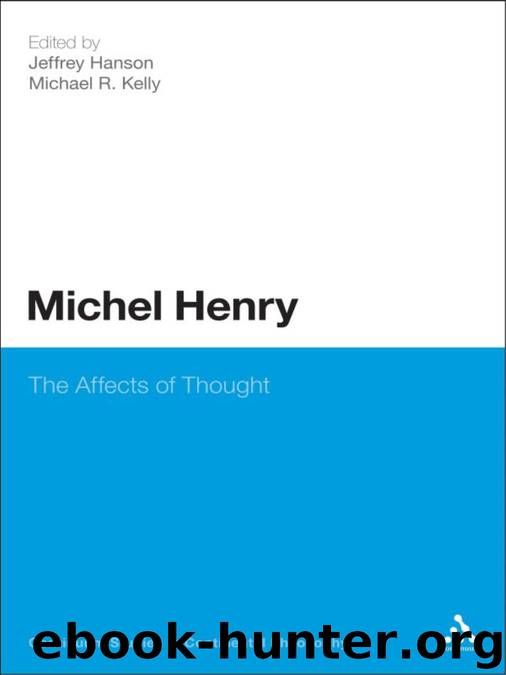Michel Henry by Hanson Jeffrey.;Kelly Michael R.;

Author:Hanson, Jeffrey.;Kelly, Michael R.;
Language: eng
Format: epub
ISBN: 9781441108333
Publisher: Bloomsbury UK
Published: 2019-11-26T16:00:00+00:00
Chapter 5
Phenomenology and Soteriology in the ‘Christian Trilogy’ of Michel Henry
Sylvain Camilleri
I. Introduction
Contemporary philosophy of religion of phenomenological inspiration is in the process of mutation, and the work of Michel Henry is playing a central role in its multiple transformations. The recent rediscovery of a lecture course by the young Martin Heidegger has provided a glimpse into the early fecundity of encounters between the discipline of phenomenology and religious life.1 It has further shown the interest of an Auseinandersetzung [confrontation] of phenomenology with certain theo-logical spheres such as eschatology. If Henry has never shown any more affinity with the young Heidegger than with the late Heidegger, it is certainly not false to suggest that he has unwittingly repeated Heidegger’s gesture on the terrain of the phenomenology of religion, since – at least in my opinion – Henry’s ‘Christian trilogy’ developed between 1996 and 2002 introduces into the philosophical scene the first serious linking of phenomenology and soteriology. In order to do justice to these two thinkers and to avoid embarrassing confusions, it is necessary from the outset to clarify first, that the phenomenology of Henry is absolutely no longer that of Heidegger and second, that the encounter evoked between phenomenology and soteriology in Henry’s oeuvre comes into view only in latent form.
The fact that Henry notoriously departs from the ‘canonical’ phenomenologies of Edmund Husserl and Heidegger and develops a radically new and different kind of thinking is something that one quickly grasps from the first pages of The Essence of Manifestation and that becomes even clearer in Material Phenomenology. Rather than simply repeat the critiques addressed to the ‘masters’ and recapitulate the cardinal principles instituted in place of the methods and concepts applied up to this point, it seems more appropriate to note that the reversal of phenomenology that Henry enacts from his very first writings still strongly undergirds his last writings devoted to Christianity.2
To note the solid phenomenological base of the ‘Christian trilogy’, the way in which it inherits innumerable macro- and microanalyses spread over almost 40 years of the development of the phenomenology of life, is useful but hardly beneficial. Why? This observation still does not say anything special about the encounter between phenomenology and soteriology in the context of Henry’s thought. This encounter – of which it is necessary to draw the contours as well as the limits – is in fact so unique that a few preliminary remarks are needed. I begin, therefore, with the observation that in the New Testament the word ‘σ ωτ ηρ ία’ covers a profound multiplicity of meanings. It is important to emphasize that certain New Testament occurrences of the word complicate the rapprochement between material phenomenology and soteriology. For example, exegetes strongly emphasize that in the Gospel of John so dear to Henry the theological specificity of the notion of salvation does not come to expression.3 This undeniable problem aside, there is no longer any doubt that the idea of salvation in the New Testament nevertheless covers a zone of signification that can reach Henry’s fundamental intuitions.
Download
This site does not store any files on its server. We only index and link to content provided by other sites. Please contact the content providers to delete copyright contents if any and email us, we'll remove relevant links or contents immediately.
The remains of the day by Kazuo Ishiguro(8350)
Tools of Titans by Timothy Ferriss(7758)
Giovanni's Room by James Baldwin(6770)
The Black Swan by Nassim Nicholas Taleb(6732)
Inner Engineering: A Yogi's Guide to Joy by Sadhguru(6418)
The Way of Zen by Alan W. Watts(6264)
Asking the Right Questions: A Guide to Critical Thinking by M. Neil Browne & Stuart M. Keeley(5328)
The Power of Now: A Guide to Spiritual Enlightenment by Eckhart Tolle(5307)
The Six Wives Of Henry VIII (WOMEN IN HISTORY) by Fraser Antonia(5206)
Astrophysics for People in a Hurry by Neil DeGrasse Tyson(4981)
12 Rules for Life by Jordan B. Peterson(4151)
Housekeeping by Marilynne Robinson(4036)
The Ethical Slut by Janet W. Hardy(4018)
Skin in the Game by Nassim Nicholas Taleb(3951)
Double Down (Diary of a Wimpy Kid Book 11) by Jeff Kinney(3890)
Ikigai by Héctor García & Francesc Miralles(3846)
The Art of Happiness by The Dalai Lama(3828)
Skin in the Game: Hidden Asymmetries in Daily Life by Nassim Nicholas Taleb(3707)
Walking by Henry David Thoreau(3667)
